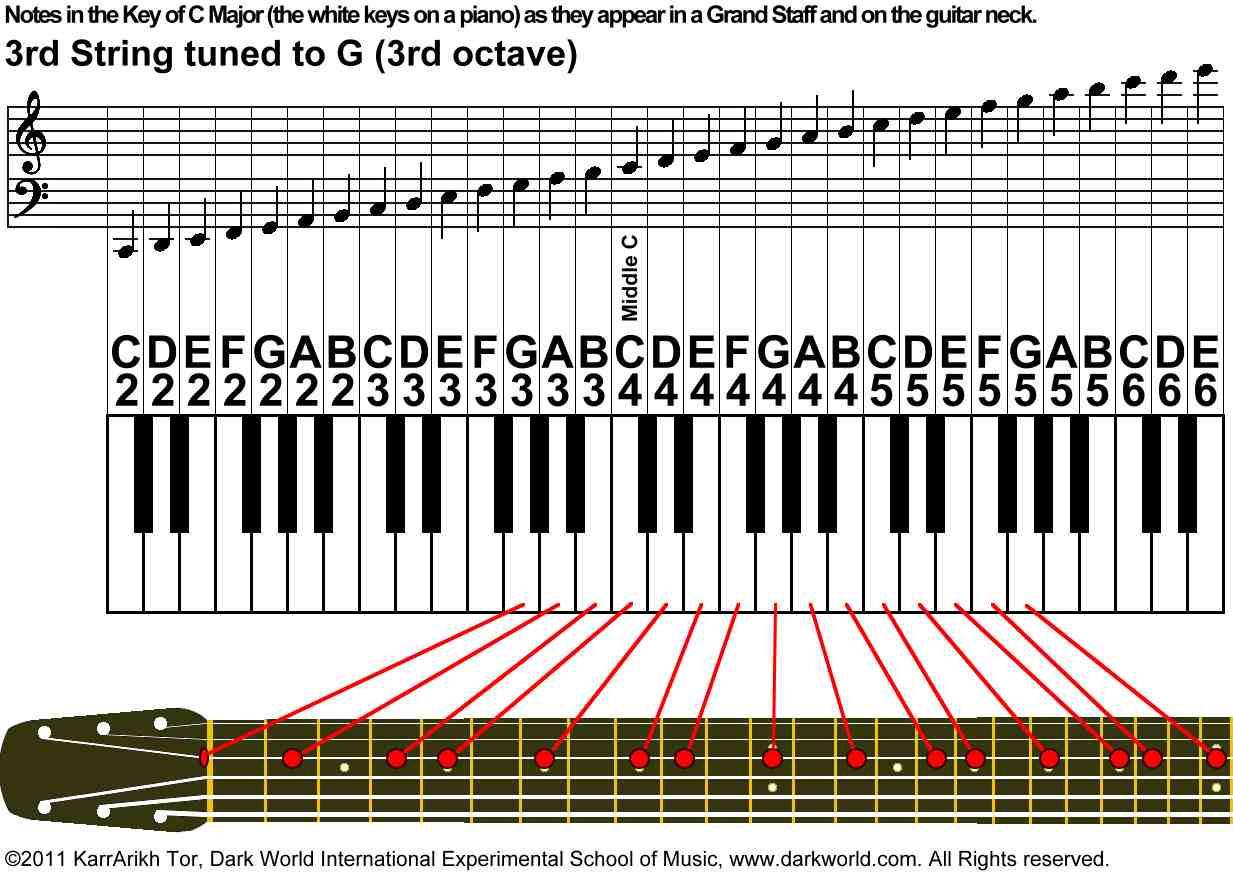Notes on Guitar Fretboard: 3rd String on Guitar

3rd String on GuitarIn Standard tuning, the 3rd String is tuned to an G in the third octave. The G is therefore played open. A is on the second fret. B is on the fourth fret. C is on the fifth fret. D is on the seventh fret. E is on the ninth fret. F is on the tenth fret. G begins again on the twelfth fret, with A on the fourteenth fret, B on the sixteenth, and so on until you run out of frets. This section shows the notes on a guitarist's fretboard, shown with 24 frets (two octaves). Guitars and their necks are designed in many styles and lengths, each with a different numbers of frets. It is good to know how many frets your guitar has, as it tells you what notes your guitar can play up to. Ignore what you can not play, play what is in your range well and with confidence. This chart shows the notes of the 3rd Sting on a guitar, where the notes are on a piano and in sheet music on the Grand Staff. All these charts are in Standard tuning for guitar. This section of charts shows the notes in the Key of C Major, the white keys on a piano, as they appear in a Grand Staff and on the guitar neck. These notes are the natural C, D, E, F, G, A, and B. Sharps and flats are represented on a piano with black keys. Note that there is no sharp or flat between a B and a C, and an E and an F. This fact is easier to learn on piano (where it may seem obvious) than it is on guitar (where frets are neither black nor white, but all a bit grey), so that a pianist many wonder why I point some things out, and the guitarist will say, "Oh, now I understand...", so I repeat myself, but music does repeat itself, over and over again. I hope to teach new guitarists this. When playing guitar, one may play any of the possible notes, but different guitar stings have different sounds. It is you, the guitarist, who must choose which place on a fretboard you like best, which is the easiest and enjoyable for you. |
about authorKarrArikh Tor has been playing guitar for over 40 years. He is the guitarist in Infinisynth, Deemed Psychotic, Future Dialogue and Tor's Angst. Being autistic with ADHD, he has a unique logical approach to things. He chooses to use colours to help define information. His book, Music Theory: The Language of Sound, demystifies guitar and bass guitar in a straightforward, easy to read manner. The Quick reference version contains all the incredible full color graphics from Music Theory: The Language of Sound in one place! The full color graphics tie the fretboards of a guitar and bass guitar to the piano keyboard and sheet music, making it a valuable tool not just for guitarists and bassists but for every member in a band. Fast and handy for any music theory student. Dutch language version of the reference guide available now. Music Theory: the Language of Sound (full textbook) The Language of Sound – in colour – Volume 1 The Language of Sound – in colour – Volume 2 The Language of Sound – in colour – Volume 3 Muziektheorie: De taal van het geluid-Naslaggids Music Theory: The Language of Sound-Quick Reference Music Theory: The Language of Sound, the book and quick reference are based on the information on this site, which KarrArikh Tor used to teach his students. The new book explains how these charts and information can be used. This website was designed only to be a quick reference resource, and was originally titled "The Dark World International Experimental School of Music". |



